Choosing a projector for the house on key parameters
If you wish to install a projector (multimedia) in your home theater, then when visiting the store you will encounter the problem of how to choose the best model. Before your eyes will be a large number of types of projection equipment, differing in parameters and technologies. Therefore, we choose a projector, taking into account the key features of the equipment.
Content
Types of projection apparatus
A multimedia projector is a device capable of projecting information from external media such as a PC, laptop, TV tuner, DVD player, tablet and even a smartphone onto an external screen (reflective surface).
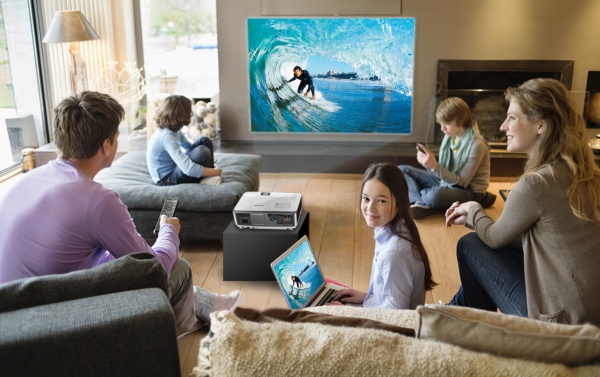
In projection devices, the most commonly used technologies for imaging are LCD and DLP. Each has its own advantages.
- LCD - devices able to produce an image with sufficient color saturation, so you can talk about high-quality color reproduction, as well as they are characterized by a high level of luminous flux. LCD devices with great clarity reproduce diagrams and texts, have many ways to connect sources of information.
- DLP - unitsIn addition to high contrast, they have excellent, natural color reproduction. With this technology, the opportunity to create micro and ultraportable devices.
Which of these technologies is better, there is no definite answer. Devices with both the one and the other method of forming images have similar characteristics and are quite high-quality devices. The difference can only be in price, since DLP devices are more expensive than LCD. Therefore, we choose a multimedia projector, based on financial possibilities.
Also for home theater there are projectors with 3D function. In addition to 3D format, they can project a regular 2D image.
Laser 3d projector is another representative of devices for projecting volumetric images. This technology allows you to get the maximum picture quality with the highest level of contrast. The image is smooth and seamless, even in very dynamic scenes. But you should understand which laser projector to choose, since the laser animated 3D device and the laser projector for the home theater are completely different devices. The animation unit is intended only for projecting volume holograms on various shows.

Main characteristics
To decide which type of projector to choose, you need to study the main characteristics of the device:
- resolution;
- light flow;
- contrast;
- weight;
- lightness uniformity;
- optics;
- image format;
- geometric distortion;
- type of lamp;
- sound;
- the number of connectors;
- control method.
Resolution
This parameter indicates how many pixels (in LCD devices) or micromirrors (in DLP devices) are located on the matrix area. For counting, the number of rows in the matrix is taken, as well as the columns.For example, if the instruction to the device indicates that the multimedia projector is equipped with a matrix with a resolution of full hd 1920 × 1080, then this means that 1920 pixels lie horizontally and 1080 pixels vertically. The higher the resolution, the clearer and higher quality projection on the reflective surface, since the pixel will then be very small.
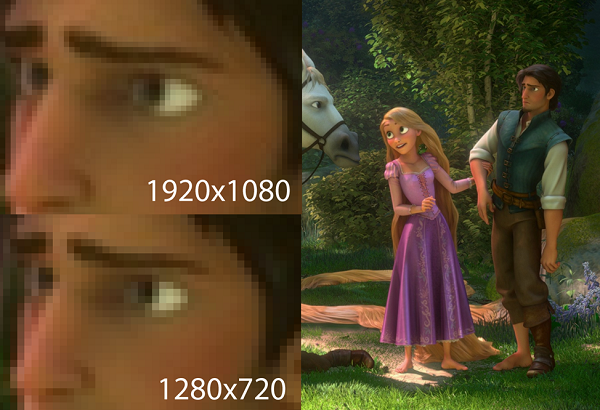
The resolution of the unit should be taken into account depending on the purpose of the projector. But still, for a home video projector recommended resolution - full hd. The table below indicates the optimum resolution of the projector, which can be used for different types of projected information.

Light flow
This value is traditionally measured in lumens, according to the ANSI standard adopted in 1982. This standard implies an average value of the amount of light flux, using 9 areas of the screen, which are evenly distributed over its area.
In modern devices, namely, in the devices of 2016-2017, the luminous flux parameter can reach 12000 ANSI lumens.
The luminous flux intensity of the apparatus that produces the multimedia projector should be chosen taking into account the characteristics of the room, the area of the reflective surface (screen) and the level of illumination of the room.To select the right parameter, you can use the table below.
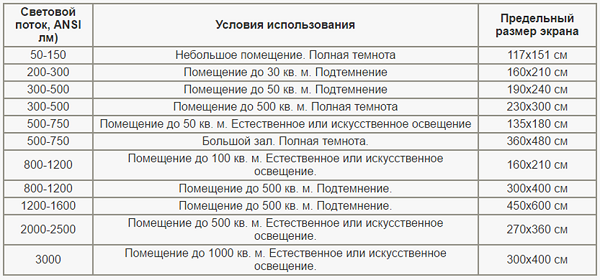
The given value is “Total darkness”Indicates that the room illumination should not exceed from 3 to 5 lux, and the device should produce at least 50 to 150 lumens. At the same time, all the windows of the room must be tightly closed. The presence of a weak light source, creating twilight.
Under the term “Darkening ” one should understand the characteristics of illumination in the area of the screen no more than 20 lux. This means that the windows that are directly next to the screen should be well curtained. But in the room it is allowed illumination, sufficient to read from a sheet of paper. Therefore, an apparatus with a luminous flux from 200 lumens to 500 lumens will be sufficient.
Under natural or artificial lighting it is understood that for the darkening of the room is not required to apply any special measures. The main thing is that the reflecting surface should not be exposed to direct light, and bright lighting fixtures should not be turned on near it, as a result of which the brightness of the projector may be insufficient.
The higher the brightness of the device, the more saturated and contrast the image will be.
Contrast
The contrast of the projector is an important indicator when selecting a projector. This value is responsible for the depth of color transmission, as well as for the visibility of objects in the darkest and brightest places in the picture.
Devices with a liquid crystal matrix have a markedly reduced contrast ratio (from 200: 1 to 900: 1) in comparison with DLP devices (from 450: 1 to 2000: 1).

But, remember that these figures can mislead you, because sometimes passport data does not indicate their binding to any standard, for example, to ANSI. If we read according to the last standard, whose values have averaged data that are related only to certain areas of the screen (except the center), then the contrast level will be 150: 1. The high contrast of the home theater projector has a positive effect when the unit is running. in a lit room.
Unit weight
Before choosing a home theater projector, pay attention to the weight of the device. Different devices by weight can be on:
- stationary, having a mass of more than 8 kg, and provided for placement on the wall or for suspended installation;
- portable, with a mass of 4 to 8 kg - such devices are convenient to use for presentations, especially in business;
- ultraportable, weighing from 2 to 4 kg;
- microportable - weight up to 2 kg.
For stationary device, it is usually a ceiling projector, a large mass does not play a special role. Unless, the device should be weighing no more than 5 kg for fixing on a gypsum ceiling.
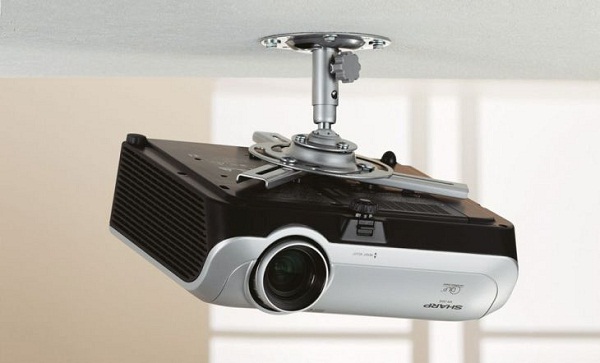
If mobility is important to you, then it would be better to buy a device with a mass not exceeding 4 kg. Such a mass and small dimensions have chinese projectorswhich can be seen in online stores. But there may be a trick: the specified parameters of the device (for example, the full hd matrix) according to customer reviews are far from being true, and the photos of how well it projects the image are also not true.
Ultra-portable devices (weight less than 2 kg) are an excellent option for people from business who are constantly traveling. Such a device is easy to take on the road. But, due to the small brightness and low power of the device, to view the picture requires a well-darkened room with a small screen.
For portable devices full hd resolution is quite affordable. These devices have excellent functionality and high technical capabilities.
Uniform illumination
The ratio of light intensity at the maximum, between the center point of the screen and its periphery, in quality devices for home use should exceed 80%.
Optical node
Most projection devices use optics to change the focal length. Such lenses are called zoom lenses or ZOOM lenses. Before choosing any type of projector, take into account that the presence of such optics makes it easy to prepare for the upcoming show, because you will not need to physically move the equipment to change the size of the picture. Advanced models provide the ability to zoom using the remote control. Also, you can remotely adjust the focus. These functions are irreplaceable if you get a stationary ceiling-type projector.
In the lungs, ultra- and microdevices, short-focus, wide-angle optics are installed in order to ensure a large image size at a distance of 1.5,up to 2 m from the screen. Short-focus lenses are convenient to use in small rooms with limited space. A wide-angle lens is often used for a device if it needs to be placed behind a translucent screen.
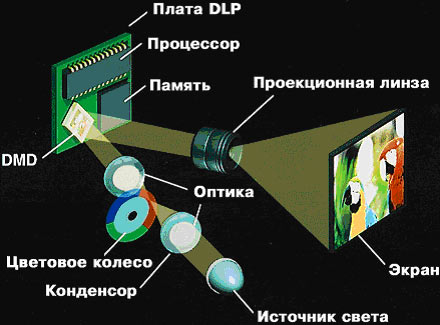
Schematic representation of the "entrails" of the DLP-projector
Image format and size
A multimedia projector, when compared with other devices for displaying information, has a great advantage because it allows adjust picture size at your discretion. Often the size of the image may depend on the size of the room and the screen. For example, portable devices are capable of projecting a picture with dimensions ranging from 60 cm to 9 m diagonally.
To adjust the size of the picture, there are two ways.
- To change the size, you need to move the device closer or farther from the screen.
- If the device's lens has the ZOOM function, the dimensions change without moving the device.
As for the picture format, the standard for projection equipment is 4: 3 aspect ratio. But newer models of devices have the ability to switch the format from 4: 3 to 16: 9, which is often used for watching movies.
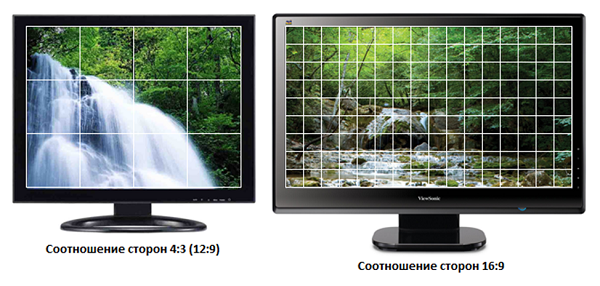
If you buy a home projector, then it is desirable that it has an LCD or DLP-matrix (widescreen) c 16: 9 aspect ratio.
Geometric Correction
When installing the device at a certain angle to the screen, for example, on the ceiling, the picture during viewing can significantly deform and become trapezoidal. To eliminate the trapezoid is used digital correctionwhich is based on compression algorithms. Some models of devices allow the ability to adjust the image, both horizontally and vertically. Because of this, you can install the device a little to the side of the center of the screen.
Sources of light
The choice of a projector is a serious matter, since the projection equipment is quite expensive. And before you choose a reliable projector for the house, pay attention to what kind of light it uses, since the cost of the lamp can reach up to 30% of the cost of the device itself.
Basically, the projection apparatus uses 2 types of lamps: xenon lamps and mercury. If you take the visual characteristics, the xenon light source is superior to the mercury equivalent.But if you take into account the service life, the mercury lasts much longer, from 1000 to 10 000 hours, while the “life” of xenon is limited to 4000 hours.
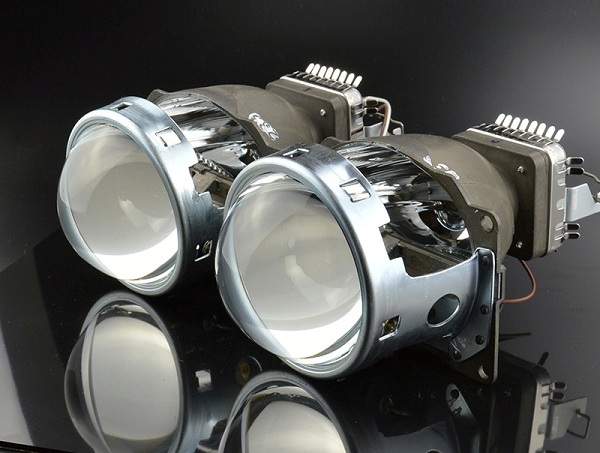
Xenon lamps
Also as a light source in the projector laser can be used. Such devices are characterized by a long duration of work, more than 20 000 hours. But the main drawback of the laser in its transcendental value.
Sound
How to choose a projector for your home so that it has sound? Everything is quite simple - you should choose a multimedia type of device. In most cases, the audio system that is built into the device has a normal volume, and is quite comfortable for inexperienced viewers. But if you want to have full surround sound in your home theater, then you cannot do without installing an external speaker system. In this case, why should you overpay for the built-in speakers in the device? You just need a projector with full hd resolution and without built-in audio system.
Number of connectors
Projection devices, including home ones, may differ in how many connectors for connecting external devices are installed in them. Modern devices have a panel for connecting peripherals, which includes standard connectorssuch as VGA interface and HDMI. Using these interfaces, digital signal reception is available up to 1080p.
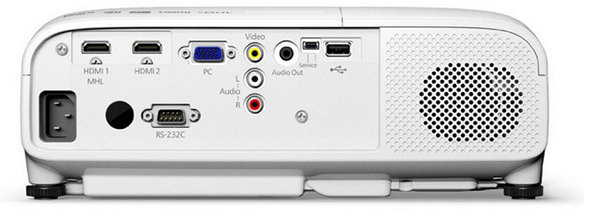
It is also mandatory in the devices provides another standard type of interface - RCA (popularly called “tulip”).
In addition to the connectors for the video signal, there may be audio outputs in the device, they may be needed to connect speakers.
Control method
A very important factor in the operation of projection equipment is the method of controlling the equipment, for which the remote control is most often used. But in modern devices there is an opportunity to control them. directly from the computervia RS-232 interface. Another way to control, for example, during a presentation, you can use a USB connection to a PC.
Summarizing, we can say that the “best” projection device does not exist, as well as the “most universal” one. The information provided above, covering the technical characteristics and functionality of projection equipment, aims to help a person in choosing the most optimal model of the device in the price-performance ratio.Using this information, you can choose the equipment that best meets your requirements.

/rating_off.png)











